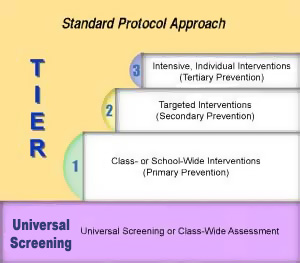
Response to intervention (RTI) is a general prevention approach that can be used within any academic area. Because the majority of the available research evidence about RTI focuses on this area, this module will focus on how the RTI approach is applied to reading. Typically, students who struggle with reading in the early grades will also eventually struggle with all academic areas. This occurs because the curriculum in upper grades relies more and more on independent reading skills. In fact, research studies have shown that it is important to assess and remediate students’ reading skills at an early age.
RTI aims to identify struggling students before they fall too far behind their peers. It is also offered as an alternative to the IQ-achievement discrepancy model used to identify students with learning disabilities. There are a number of advantages to implementing this approach for both of these purposes. For instance, RTI:
research-validated practice A strategy or practice that has been proven to work through experimental research studies or large-scale research field studies. Known by a number of names, including scientifically based practices and evidence-based instruction.
standard protocol approach
An approach to RTI that uses a validated intervention (selected by the school at Tier 2) to improve the academic skills of its struggling students; an alternative to the problem solving approach. Sometimes also referred to as the standard treatment protocol approach.

Though there are several approaches to RTI, when the term RTI is used in this module, it refers to the standard protocol approach (sometimes referred to as standard treatment protocol approach) because the S-Team at Rosa Parks has decided to use this particular approach at their school. This module will continue the Rosa Parks story.
RTI consists of the following components:
Universal Screening or Class-Wide Assessment. Universal screenings are used to identify students’ current levels of academic achievement. Students whose achievement is less than desired are identified.
Tier 1: Class- or School-Wide Interventions (Primary Prevention). All students receive high-quality classroom instruction using empirically validated techniques. Students receive frequent progress monitoring of academic skills, and those who do not meet desired benchmarks become eligible for Tier 2 services.
Condition or characteristic of having been proven through high-quality research to be accurate or to produce positive results.
Tier 2: Targeted Interventions (Secondary Prevention). The standard protocol provides all students receiving Tier 2 with the same, empirically validated intervention. This intervention is often provided in a small-group setting for a set period (anywhere between 10–20 weeks), with frequent progress monitoring. Students within the small groups may possess heterogeneous or homogeneous skills. Typically, the validated standard protocol includes instruction in several sets of skills so that each child’s needs can be met, even with heterogeneous grouping. For example, a small group might include one student who has problems with reading fluency, another who has poor phonemic awareness, and another who has difficulties with phonics skills. The intervention the group members receive is the same, with time devoted to each skill area (e.g., phonemic awareness, phonics, vocabulary, reading fluency, and comprehension).
Tier 3: Intensive, Individualized Interventions (Tertiary Prevention). State and district policies determine the options at Tier 3. In one of these, students who still do not make adequate progress with Tier 2 intervention can receive more intensive interventions. In another option, students receive special education services if abbreviated or comprehensive evaluation results verify the existence of a disability.
For a more detailed explanation of the overall RTI process and the standard protocol approach, view the IRIS Module:
The RTI approach relies heavily on assessment. In each component of this multi-tiered approach, assessment is crucial for making informed decisions about the level of instructional intensity that would benefit students. This module, therefore, will explore in detail the assessment procedures integral to RTI.
The four primary functions of RTI assessment are to:
It is important to note that this module will discuss a variety of assessment options. Each state or school district will decide which options will best serve the needs of its students, given the available resources.